The Great Recession of 2008 was the worst global economic downturn since the Great Depression of the early 20th century. In North America, the big-three car manufacturers (General Motors, Ford, and Chrysler) suddenly found themselves in trouble as increasing fuel costs meant that consumers could no longer justify their love affair with the gas-guzzling SUVs and trucks these companies had focused their marketing and manufacturing on. With SUVs sitting on dealer lots across the continent and few buyers to be found, governments in both Canada and the US intervened to bail out GM and Chrysler with massive loans. Taxpayers were told the failure of these automotive behemoths would have meant further economic hardship for the rest of us. So much for the laissez-faire economics of capitalism.
GM immediately set about restructuring by eliminating models from their lineup and dropping their Oldsmobile, Pontiac, and Saturn brands altogether. In hindsight, this seems like an obvious move. I was living in Whitby, Ontario, during the 1990s; a city adjacent to Oshawa, the biggest General Motors manufacturing hub in Canada. Not surprisingly, a lot of people there drove GM vehicles. What was unusual was the number of models GM built, and how redundant many appeared to be. For example, the GMC Yukon and Chevrolet Tahoe were essentially identical, save for the branding inside and out. Same goes for the Chevy Silverado and GMC Sierra, as well as the Chevy Suburban and GMC Yukon XL. There are other examples (and some remain to this day).
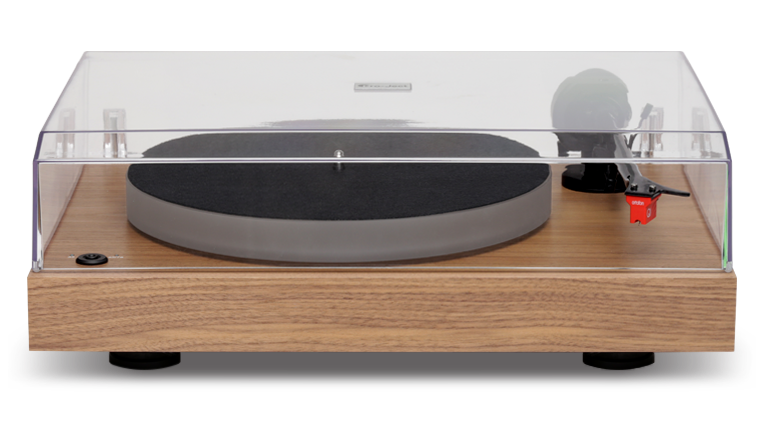
What does any of this have to do with high-end audio? Well, the subject of this review is a relatively new turntable introduced by the Austrian analog giant, Pro-Ject Audio Systems. At the time of writing, I counted a whopping 36 turntables in the Pro-Ject catalog, not including special editions and models from its artist collection. Some of these turntables are slight variations on a base model, adding a phono stage here and/or Bluetooth connectivity there. Furthermore, most of them have multiple finish options. Admittedly, unlike many of the GM trucks I mentioned, these turntables aren’t simply rebadged versions of each other, but I would argue there still is some overlap in their design. When one of the largest and most successful turntable manufacturers in the world sent me yet another new model for review, I couldn’t help but draw parallels between Pro-Ject and General Motors, the planet’s biggest vehicle manufacturer before the crash of 2008.
Pro-Ject X2 B
The X2 B is the third turntable I’ve reviewed from Pro-Ject. Since each deck has belonged to a different series, model overlap hasn’t been an issue. Initially I wrote about the T1 Phono SB ($399, all prices in USD except where stated), followed by the Debut Pro with Pick it Pro cartridge ($1099 CDN, $999 in the US with Sumiko Rainier cartridge). At $2379 CDN in Canada, shipped with an Ortofon Quintet Red MC cartridge ($1799 in the US with a Sumiko Rainier cartridge), the X2 B could be considered the next rung up on the Pro-Ject ladder. What makes it unique is its balanced output; something that is rare for any turntable, and with which I had no experience. The Sumiko Rainier cartridge shipped as standard in the US is a moving-magnet design, which should not be run balanced.
Balanced connections originated in professional setups (such as at studios and live concert venues), where long cable runs are susceptible to picking up noise and interference on the lines. While this is less of an issue for home audio systems, which don’t typically include balanced connections, Pro-Ject cites electromagnetic fields from wireless networks and smart devices as another source of potential interference. The X2 B (and accompanying Phono Box S3 B) is intended to address this concern.
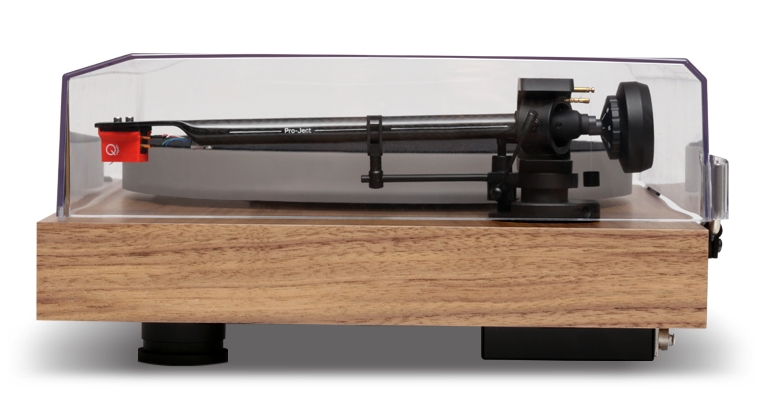
Marketed by Pro-Ject as its “True Balanced Connection,” this setup uses three wires for each channel: ground, positive, and negative (the latter two are often referred to as “hot” and “cold”). The audio signal from the turntable is carried by the positive wire, while the negative wire carries the same signal but reversed in polarity. Any noise picked up by the cable will be added to both the hot and cold signals. When they arrive at the phono preamplifier, the cold signal is inverted and added to the hot signal. When the cold signal is flipped, so is the noise, and when summed together the noise is canceled out. This is the principle behind how all balanced circuits operate, but it’s unusual to see it in a turntable and phono preamplifier.
The X2 B is a belt-driven design with electronic speed control that can be adjusted with a push of the button on the lower left of the plinth. It’s capable of operating at 33⅓, 45, or 78 rpm, with the highest speed requiring a round belt wrapped around the larger pulley to rotate the subplatter (the lower speeds use a flat belt). The subplatter’s stainless-steel bearing is said to have extremely low tolerances. The solid-acrylic main platter is 1.2″ (30mm) thick and weighs in at nearly four-and-a-half pounds. The motor that drives the platter has its own suspension, and a precisely tuned thermoplastic elastomer (TPE) belt decouples the motor chassis from the plinth. A major benefit of belt-drive over direct-drive turntables is that vibrations generated by the motor are isolated from the platter, so are less likely to affect the information retrieved from the record’s groove by the needle.
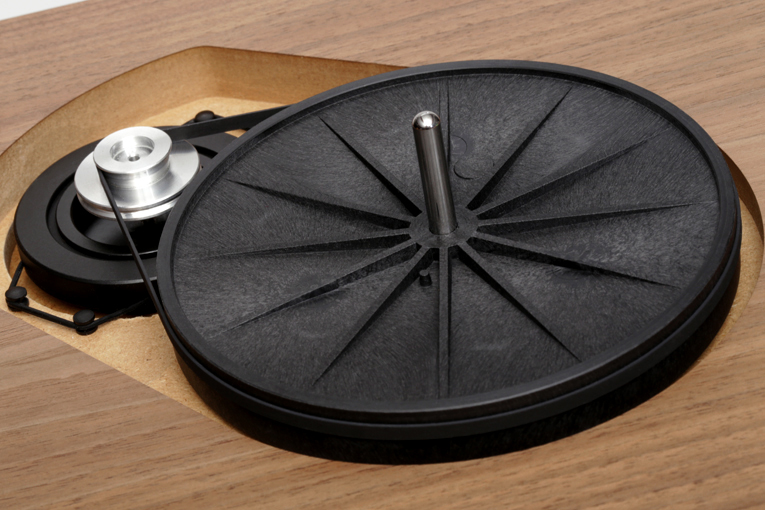
At just under 2″ (50mm) thick, the substantial MDF plinth sits on height-adjustable and vibration-absorbing machined-aluminum feet that allow precise leveling of the playing surface. My review sample came wrapped in satin walnut wood veneer. High gloss black, satin black, and satin white eight-layer, hand-polished finishes are also available. With dimensions of 18″W × 6″H × 13.5″D (including the dust cover) and a total weight of approximately 22 pounds, the X2 B is about the average size for a record player, but it certainly feels far more substantial than entry-level decks.
The one-piece, 9″ tonearm comprises an aluminum tube wrapped in carbon fiber. According to Pro-Ject, these materials provide optimal damping and rigidity. At the end of the tonearm is a counterweight that is damped with the same TPE material used to isolate the motor. There are two grub screws at the arm’s aluminum base to adjust its height, enabling the vertical tracking angle to be dialed in precisely. This is useful if you favor a thicker record mat, or want to experiment with different cartridges. Furthermore, azimuth can also be adjusted to ensure the cartridge tracks correctly.
As I said, the X2 B ships with a premounted Ortofon Quintet Red moving-coil cartridge in Canada and elsewhere outside the US. Featuring an elliptical diamond stylus, the Quintet Red touts itself as a good entry point into Ortofon’s range of MC cartridges. While the X2 B—largely because of its 9″ tonearm—presents a good platform for experimenting with more expensive MCs, I think Pro-Ject has found a good partner in marrying its X2 B with the Quintet Red, and I can easily see someone living happily with this combo until the cartridge needs replacement.
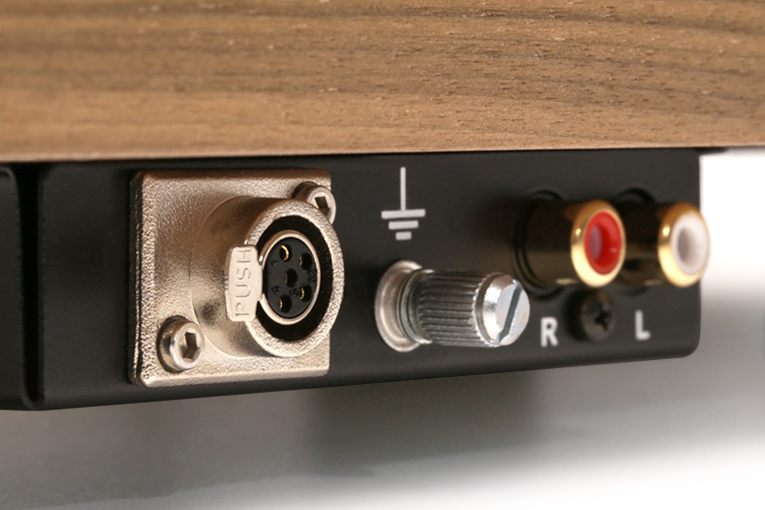
Mounted on the back and underside of the plinth, a pair of RCA plugs and one mini XLR output are provided, depending on whether the deck will be run single-ended or balanced. The 15V DC / 800mA power-supply plugs in on the opposite side of the deck underneath the motor (where else?) and includes adapters so it can be used anywhere in the world. The ’table comes with a Connect it Phono E RCA cable, which I used for this review when operating it single-ended. I did not however use the included felt mat. As with my own Thorens turntable, I placed records directly on the platter—static electricity has a way of “sticking” felt mats to my records so that they come off together when I change records. If it made a discernible difference in sound, I’d tolerate this, but to my ears and my patience, it isn’t worth the trouble.
Much like the T1 Phono SB and Debut Pro, I found the appearance of the X2 B attractive. I haven’t seen it in any finish other than the walnut wood veneer of my review sample, but if I were buying this unit, I’d likely opt for this finish anyway. Along with the acrylic platter and carbon-wrapped tonearm, the walnut gives the deck a look that is at once modern and classic. The overall appearance is clean and will age well; an important consideration when making this sort of investment.
Companion Phono Box S3 B
At $499, the S3 B is a surprisingly full-featured phono preamplifier and a natural partner to the X2 B. Most importantly, its balanced architecture sets it apart from most others on the market. A mini XLR input on the backside permits the connection to the balanced output of the X2 B deck, and XLR outputs deliver a balanced signal to a compatible preamplifier. When they sent me the review samples, Gentec International provided me with Pro-Ject’s Connect it Phono S mini XLR/mini XLR cable so I could hear the two pieces in balanced mode. Alternatively, standard RCA connectors are provided if you aren’t set up to use the S3 B’s balanced innards. Less advertised but just as interesting, the S3 B employs discrete rather than integrated circuits in the gain stages. Using separate components to construct the amplifier section costs more but, Pro-Ject claims, results in the best sound quality.
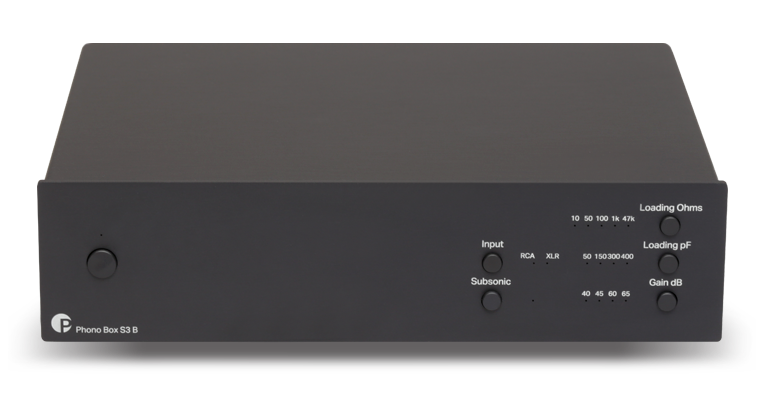
My favorite feature of the S3 B was the set of small buttons on its front panel that allow you to experiment with gain, loading, and capacitance settings. No need to open the casework and adjust jumpers or DIP switches for these tasks. For reviewers this is a bonus, but it’s important for any user: it permits on-the-fly adjustments that allow you to hear different settings instantaneously, making it a cinch to dial in the best setup for your cartridge. I’ve never encountered a phono stage this user-friendly and it’s a big selling feature. Assuming the S3 B sounds good, I’d consider owning it for this reason alone.
Settings of 10, 50, 100, 1k, and 47k ohms can be selected for impedance, while 50, 150, 300, or 400pF can be chosen for capacitance. Gain can be set to 40, 45, 60, or 65dB, with an additional 6dB on any of these settings when the S3 B is run balanced. The inclusion of a subsonic filter with an 18dB/octave cutoff below 20Hz is also selectable on the front panel, although I never ended up using it.
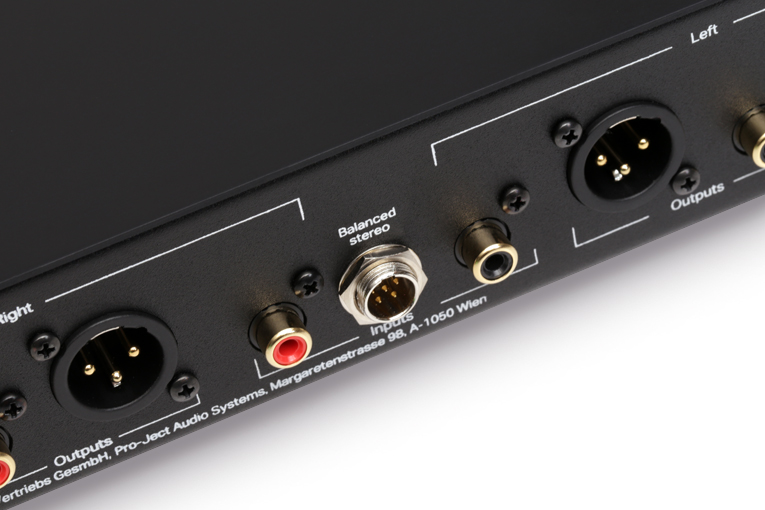
With modest dimensions of just 8.1″W × 2.2″H × 6.4″D (including sockets) and a steel-and-aluminum chassis that should help shield it from electromagnetic interference, the S3 B looks handsome while occupying a small footprint on the equipment rack. If you’re somewhat space-limited but want the benefits of an outboard phono stage, this new model from Pro-Ject is a good proposition. The fact that it’s manufactured in Europe, like the X2 B deck, makes ownership even more compelling.
The X2 B replaced my Thorens TD 160 HD turntable with modified Rega RB250 tonearm and Sumiko Songbird low-output MC cartridge. Initially, I connected it to a Saturn Audio 401 phono preamplifier ($2900) using the supplied Connect it Phono E RCA cable. Generic RCA cables linked the 401 with a Bryston B135 SST2 integrated amplifier. A set of Nirvana Audio Royale speaker wires, terminated in spades, delivered power to Monitor Audio Gold 300 5G tower speakers. All electronics were plugged into an ExactPower EP15A power conditioner.
Pro-Ject X2 B with the Saturn 401
I paired the X2 B with my Saturn Audio 401 phono preamplifier because I wanted to start by hearing the turntable on its own, without the partnering Phono Box S3 B. Potential buyers won’t necessarily use it with the S3 B, and besides, I didn’t want to complicate things by swapping two components out of my system at the same time.
Mick Jagger apparently thought otherwise, but the Rolling Stones’ Exile on Main Street (Universal Music Group Recordings B0014203-01) is a well-produced album. This is apparent as soon as the stylus meets the vinyl. “Rocks Off” is superbly engineered, presenting a soundstage that’s reasonably wide and multilayered, and one where it’s easy to tease apart what’s happening across it. Vocals aren’t buried on Exile, but sometimes they are a bit more laid-back; something that tends to focus attention on the rest of the musicians.
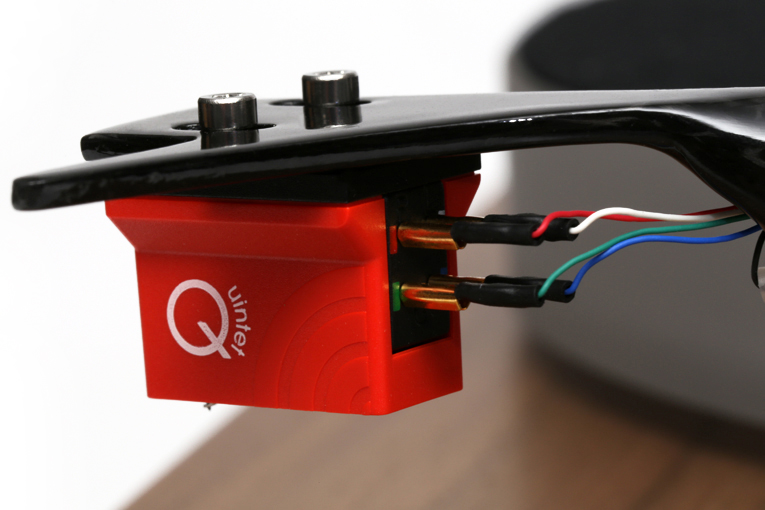
As its title suggests, “Rip This Joint” is a rocking tune that roars out of the starting blocks. Its energy and drive were well served by the X2 B, whose fast and precise sound ably portrayed the infectious tempo of the track. The drum kit sounded tight, but it’s the saxophone that steals the show, elevating the vivacity of this bluesy gem altogether. Most impressive for me was the deck’s ability to keep everything well sorted and clear in front of me. The X2 B sounded commendably clean, which made horns and harmonicas alike “pop” from the music while still preserving the deck’s inherently balanced character. Good stuff.
The strumming of the acoustic guitar on “Sweet Virginia” simply sounded natural, while the backing singers that add depth were clearly delineated behind the lead vocals. Listening to this track through the X2 B, there was a real sense of being at the sessions, hearing these musicians put it together. The stories behind the making of Exile are well-documented, and experiencing it through the X2 B gave me a pretty good sense of being a fly on the wall in the studio.
Exile isn’t an album of singles, and it took some time before it was embraced as the classic it was destined to become. It works well as a whole album, and with the X2 B I just let it play. The influence of music from the American South can be heard everywhere across these songs, and the only thing missing for me as I enjoyed this classic record on the Pro-Ject turntable was a tumbler of Jack Daniels.
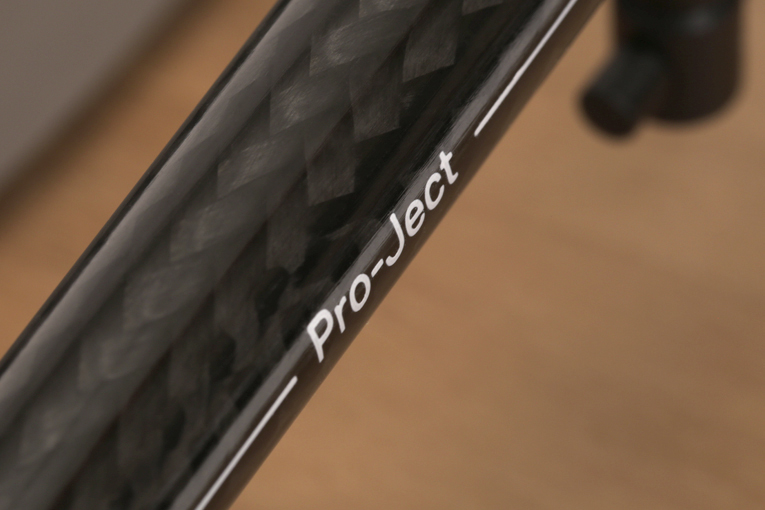
Switching gears but maintaining the tempo, I cued up Georges Bizet’s Carmen (RCA Victor LM-6102). Performed by the RCA Victor Orchestra and conducted by Fritz Reiner, the music immediately sweeps up the listener in the sheer drive and vitality of the playing. Many people will recognize this music even if they can’t name it. Although the X2 B revealed the somewhat constrained dynamics in the recording, the uplifting spirit of the opening of this opera was readily conveyed, and a good sense of space emerged despite the higher-than-normal surface noise of my copy.
When the vocals enter, their closer proximity to the listener enhanced the perception of stage depth. A trumpet entering at one point in the opening act really demonstrated how far back the soundstage stretched; as it came to the fore, the X2 B revealed its bright, shiny tone, sounding like a cry to rally the cavalry to battle. The triangle’s ring was crystalline, while the sound of the cello had a pleasing weight and richness.
Moving on to Charles Mingus’s Mingus Ah Um (Columbia Records / Legacy Recordings 88697-335681), the X2 B tracked the frenzied tempo of “Bird Calls” with precision; the shimmer of the cymbals was vivid, and the drum kit’s location emphasized the depth of the soundstage. The tone of the horns was conveyed with superb clarity, expanding the width of the performance across the front of the room. On “Fables for Faubus,” Mingus’s upright bass was rich but clear, and I could easily feel its woody resonance from my listening chair. Mingus Ah Um is an astoundingly good recording, due in no small part to the palpable sense of space that gives each musician a clear outline one can almost see. For its part, the X2 B did nothing but present Mingus Ah Um faithfully, without editorializing or imparting itself onto the recording. For listeners such as me that prefer neutrality, the X2 B is an easy recommendation; if you’re looking for a warmer, looser sound, you won’t find it here.
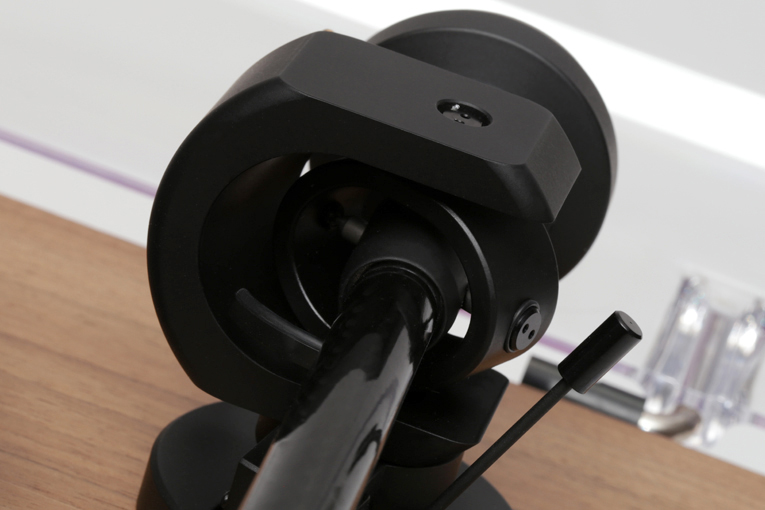
Cueing up Beethoven’s Symphonie Nr.5 (Deutsche Grammophon 138 804), the X2 B was a worthy conduit to showcase the raw power of the opening movement of Beethoven’s Fifth. The sheer intensity of the strings and brass was almost unnerving, and I wonder what audiences thought when they heard the work performed for the first time, two centuries ago. The Pro-Ject spread the Berlin Philharmonic, conducted by Herbert von Karajan, across a reasonably wide soundstage that didn’t really extend beyond the outer boundaries of the speakers, but certainly filled the space between and behind them, enhancing the three-dimensional presence of the orchestra.
In the fourth and final movement, the blare of the brass was invigorating and was underscored by the richness of the cellos. There’s an incredible sense of calm at the end of the third movement that climaxes in a moment of soaring triumph, and the dynamics of this passage were well served by the Austrian turntable. I have a German pressing of this recording that has its share of pops and crackles, but the music played through the distortions as if they weren’t even there. The X2 B made it easy to ignore them, allowing the sound of cellos and flutes to move through with excellent continuity; such is the fluid character of vinyl, and the reason one would invest in a better-quality deck.
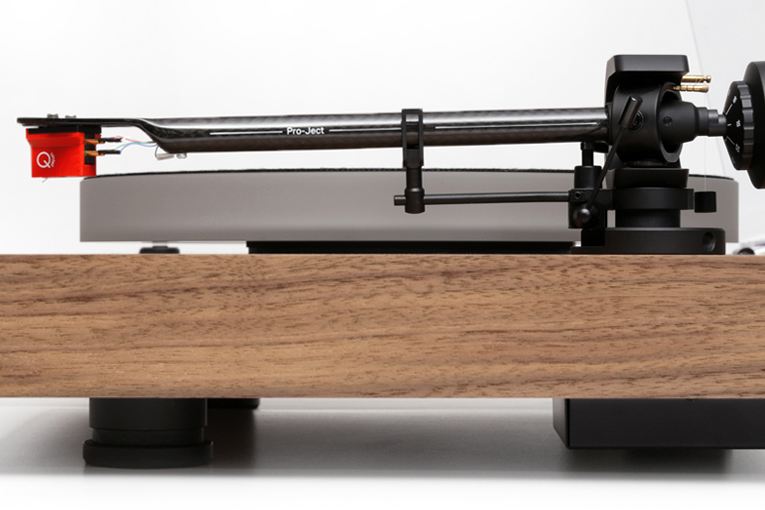
Much like the Roksan Attessa turntable I just reviewed, the X2 B offers an excellent package for a consumer looking for a mid-tier ’table. It makes for a beautiful display, and you’ll likely enjoy seeing it at the front of your room as much as I did. It sounded clean and detailed, with little character of its own; all attributes that, in addition to vinyl’s inherent warmth, allow you to appreciate how great an analog setup can sound. Some audiophiles will scoff at my suggestion that the X2 B’s relatively modest price makes it “mid-tier,” but most regular folks (i.e., non-audiophiles) would think it’s a lot of money to spend just for a source component. I’d argue it’s a pittance compared to what one can spend if price is no object, even if stratospherically priced turntables only represent a tiny segment of the market.
Comparison: Pro-Ject X2 B and Thorens TD 160 HD with the Saturn 401
Swapping the Pro-Ject / Ortofon for my Thorens TD 160 HD / Sumiko Songbird combo to listen to Beethoven’s Fifth Symphony again, my first observation had nothing to do with the sound, but rather, that the Pro-Ject had a more powerful motor. Both turntables have acrylic platters, and as I mentioned, I don’t use a record mat. After listening to the first side on the Thorens, I flipped the disc and cleaned the second side with my brush. Even though I merely floated the brush over the surface, applying minimal pressure, the record nearly came to a stop. The Pro-Ject had no such issue. The record slowing and almost stopping on the Thorens doesn’t happen every time I play an album, but it does happen occasionally and is due to the TD 160 HD’s low-torque motor.
Through the Thorens–Saturn combo, the shiny blare of the horns and clear tone of the strings that accompany them in the opening of the third movement were well sorted, and the cellos sounded rich and full. Toward the end of this piece the music passes through an almost eerily quiet transition that is heard from far back on the stage. As the final movement opens, the music pans out from there, exploding in a jubilant grandiosity that washes over the orchestra. The TD 160 HD provided a clean, open view onto the Berlin Philharmonic, producing a stage of commendable depth.
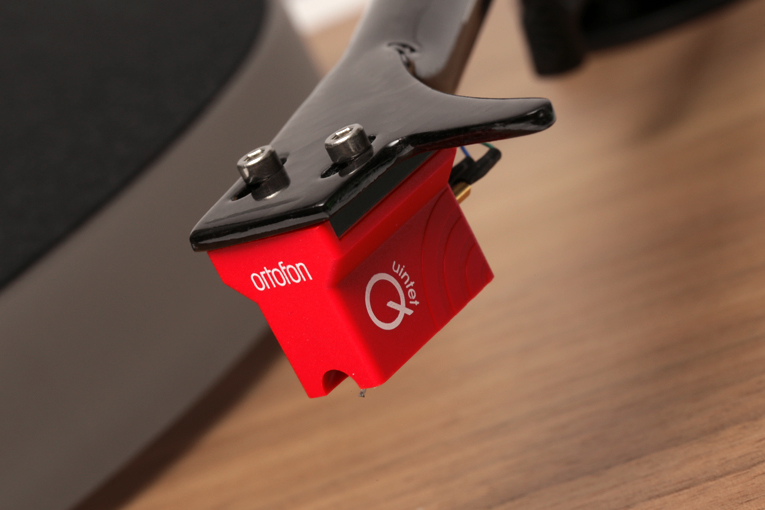
Switching back to the Pro-Ject, the Austrian turntable conceded little to the Thorens. I found the Pro-Ject’s presentation of the orchestra was a bit more upfront, bringing music out into the room more, while still producing a depth comparable to that of the Thorens. In the same passage where the third movement segues into the fourth I could feel the power and drive of the orchestra, which gave the piece a real sense of scale and grandeur. The music’s dynamism and sheer force were lucidly communicated by the X2 B. For its part, the Thorens was notable for the spaciousness on the stage, as though the air around the instruments was more apparent. I can’t imagine a listener liking one of these models but not the other. Both sounded fantastic and demonstrated why it’s worth spending the extra money for this level of performance.
Returning to Carmen through the Pro-Ject–Saturn combo, the boisterous exuberance in the first scene of Act I was energetic, with the RCA Victor Orchestra positioned between and well behind the speakers. The voices of the soldiers as they admire and then harass Micaela to join them for a drink were as clear and articulate as the limitations of this recording would allow. Through the Thorens–Saturn combo, the orchestra seemed to open up slightly, as individual elements were teased apart. They weren’t highlighted in a way that was unnatural, but rather had a touch more space around them. When compared head-to-head, the Pro-Ject’s soundstage was a touch constrained.
Pro-Ject X2 B with Pro-Ject Phono Box S3 B
My initial intention was to run the S3 B phono preamp balanced since this is one of its key features. However, I began by connecting it to the X2 B deck using the supplied Connect it Phono E RCA single-ended cables and found it sounded remarkably good. In fact, for $499, it was fabulous. Music was presented against a quiet background and spread across a broad stage. On Carmen, each section of the orchestra remained distinct, and the voices of the soldiers in the opening act had a decent amount of space around them. Switching over to a balanced connection using the supplied Connect it Phono S mini XLR to mini XLR, I didn’t hear much of a difference. Initially I thought I detected a slight drop in the noise floor, but as I switched back and forth, I couldn’t be sure. The rest of my system isn’t balanced, and my cable runs are generally short, so this may have had something to do with it. If I owned this turntable and phono preamplifier, I’d likely run them balanced since that’s what they’ve been designed for, but I would never suggest that the S3 B’s balanced output is the only reason to buy it. I was equally impressed with its single-ended performance and when one factors in how easy it is to experiment with impedance, loading, and gain settings, the case for ownership becomes greater. At $499, the Phono Box S3 B is a bargain. There is no other way to describe what it offers for the price.
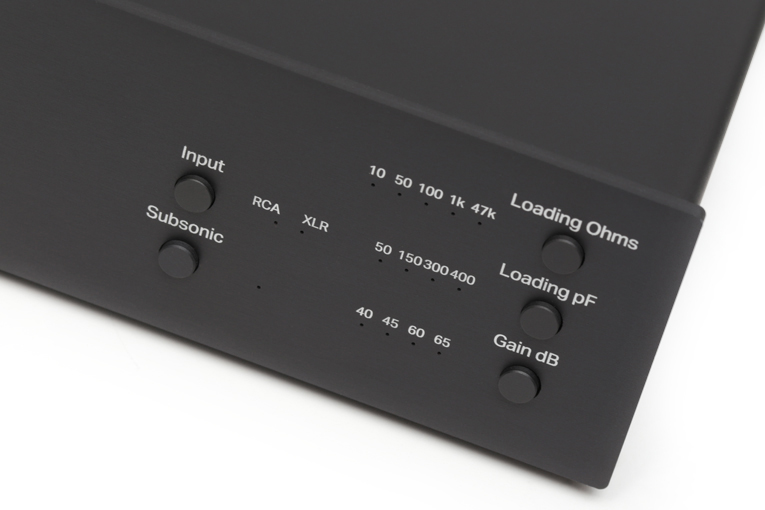
Next up I played Aerial Boundaries, by Michael Hedges (Windham Hill Records WH-91032). Through the RCA connectors, his acoustic guitar sounded precise; the lowest notes he struck resonated through the wood body, conveying a wonderful sense of fullness. As always, I found myself impressed with how much sound he’s able to extract from this instrument, and the suppleness of his technique was well conveyed through the X2 B/S3 B combo. His playing is incredibly clean, and he coaxes sharp transients from the strings that jump out into the room. Again, I switched over to the balanced cable, something that was a snap to do with a button on the front of the S3 B, and much like with the Bizet recording, it sounded the same as the single-ended connection. I’d never wager any money on my ability to reliably distinguish between the RCA and XLR connections in a blind listening test. Like I said, the S3 B performs admirably with both.
Comparison: Pro-Ject X2 B–Phono Box S3 B vs. Thorens TD 160 HD–Saturn 401
My final comparison for this review was to compare the Pro-Ject setup with my own analog rig. Much as I’d heard when I compared the two turntables through the Saturn 401, listening to the opening movement of Carmen revealed different sonic personalities from each deck. However, I’d argue that these differences were more pronounced when the Pro-Ject was partnered with its companion S3 B. Through the Pro-Ject duo, the orchestra sounded precise and well controlled. I wouldn’t say the Thorens–Saturn combo lacked control, but it traded some of the Pro-Ject’s focus and tightness for a fuller, somewhat warmer character. There was more bloom through my own rig combined with a greater feeling of space within different sections of the orchestra. The Saturn 401 on its own costs more than the X2 B and S3 B combined, so perhaps this shouldn’t have been a huge surprise. A more direct comparison would have been with a pricier Pro-Ject setup. Both setups offered excellent resolution.
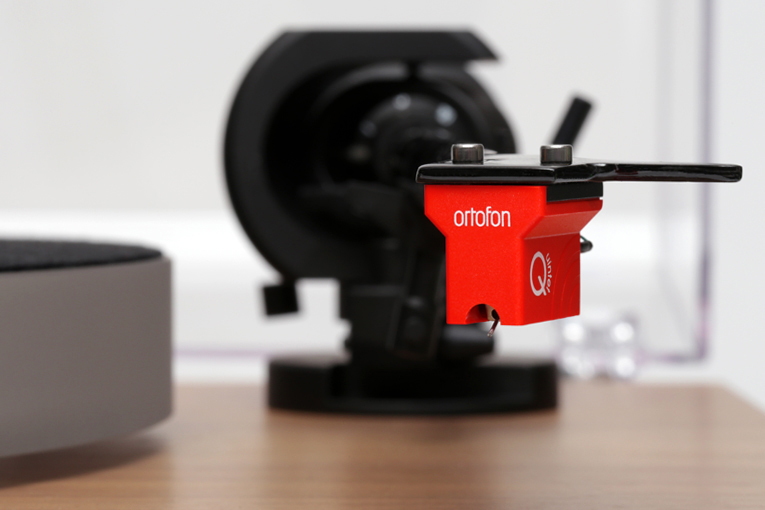
Ultimately the X2 B–S3 B combo was never embarrassed by the Thorens–Saturn; its sound was simply a bit drier and tighter. Neither setup was able to extend the stage outside the boundaries of the speakers, and while the Pro-Ject setup equaled the soundstage depth of the Thorens–Saturn combo, it lacked the latter’s sense of spaciousness and fullness within that stage. The overall sound of each setup will certainly appeal to different listeners, depending on where one’s sonic priorities lie.
Conclusion
Pro-Ject does produce many turntable models, but perhaps it was unfair of me to draw a parallel between the Austrian hi-fi company and a North American auto manufacturer. While parts are undoubtedly shared among the various models, including crucial components like tonearms, speed controls, and motors, the execution of the designs is what separates them. Based on Pro-Ject’s massive global analog presence, the company knows far more than I do about the audio market, and offers an impressively broad catalog of products that caters to it.
Like the company’s T1 Phono SB and Debut Pro I reviewed earlier, the X2 B has a clean, precise character that nonetheless still sounded sufficiently full, and deserves praise for its neutrality. Though I couldn’t discern the benefits of running it balanced, its wonderful single-ended performance made that a nonissue. Of course, this was only my experience and, in a different setup, another listener may find that running it balanced has a significant effect on the sound.
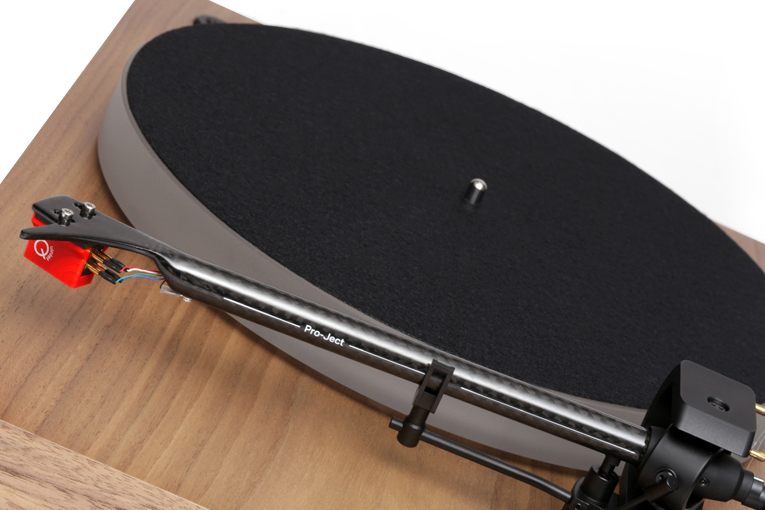
As much as I enjoyed my time with the X2 B, it was the S3 B that most surprised me. If I were looking for a phono preamplifier in this price range, I’d buy it without question. First and foremost, it sounded good, and shares similar traits to the X2 B itself. However, it was its flexibility and usability that finally won me over, along with its relatively modest price. Only a company the size of Pro-Ject could build a product like the S3 B for $499, particularly in Europe; I think a smaller competitor would have a difficult time trying to match it.
If you have $2000 to spend on a turntable but already own a phono stage you like, I wouldn’t hesitate to recommend the Pro-Ject Audio Systems X2 B. It’s another in a long line of solid offerings from the company. If you don’t have a phono stage, pairing the X2 B with the Phono Box S3 B is an even easier recommendation. Try running them both single-ended and balanced and see what you prefer (as noted above, in the US, the X2 B ships with a moving-magnet cartridge that is intended for a single-ended connection). Regardless, you’ll be the proud owner of two finely made components that are certain to provide years of listening enjoyment.
. . . Philip Beaudette
philipb@soundstagenetwork.com
- Speakers: Monitor Audio Gold 300.
- Phono stage: Saturn Audio 401.
- Integrated amplifier: Bryston B135 SST2.
- Analog source: Thorens TD 160 HD turntable, Rega Research RB250 tonearm, Sumiko Songbird moving-coil cartridge.
- Speaker cables: Nirvana Audio Royale.
- Power conditioner: ExactPower EP15A.
Pro-Ject Audio Systems X2 B Turntable with Ortofon Quintet Red Cartridge
Price: $2379 CDN in Canada with Ortofon Quintet Red cartridge, $1799 in the US with Sumiko Rainier cartridge.
Warranty: Two years, parts and labor.
Pro-Ject Audio Systems
Margaretenstrasse 98
A-1050 Vienna
Austria
Email: info@project-audio.com
Website: www.project-audio.com
Canadian distributor:
Gentec International
90 Royal Crest Court
Markham, Ontario L3R 9X6
Phone: (905) 513-7733
Website: www.gentec-intl.com
US distributor:
Fine Sounds Americas (formerly Sumiko Audio)
9464 Hemlock Lane North
Maple Grove MN 55369
Phone: (510) 843-4500
Fax: (510) 843-7120
Email: service@sumikoaudio.net
Website: finesounds.com






















